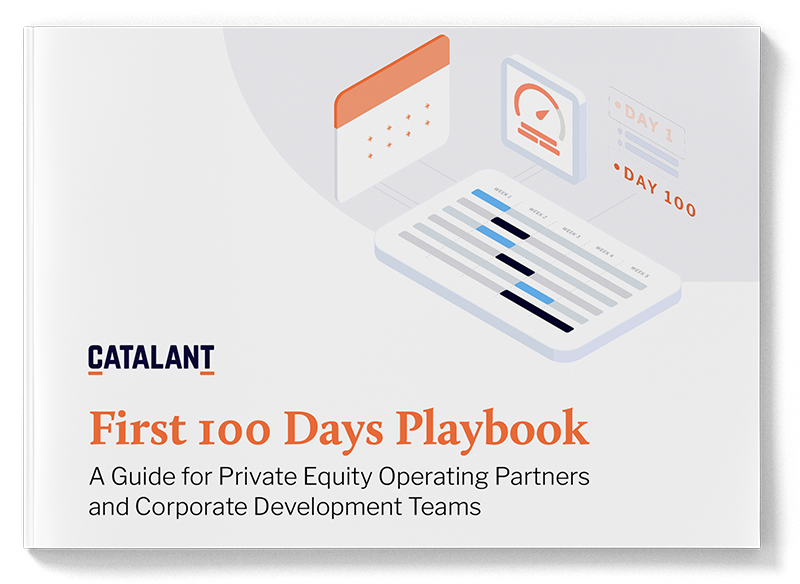Commercial Success in M&A: Integration strategies to capitalize on opportunity

This article is part of the latest issue of the Catalant Quarterly: “The ‘First 100 Days’ Strategy: A Blueprint for Accelerated Value Creation.” Read the issue here and download the First 100 Days Playbook.
M&A activity is increasing after a drought of a few years. M&A is a high-stakes game of maximizing synergies and rapidly integrating to unlock value. As companies grow through acquisition, the challenges and complexities of integrating these new entities can be formidable, especially in commercial functions like sales and marketing.
There will always be back-office synergies to be found in Finance, HR, IT, etc., but typically, the most enticing aspects of these acquisitions is the potential for new revenue and new customers. While a fully transparent view of go-to-market strategies cannot be shared during due diligence, it is almost guaranteed that the companies being combined will have some overlap of existing customers and pipeline opportunities.
Ensuring effective integration and maximizing commercial opportunities in the first 100 days of a transaction requires a thoughtful and proactive approach. This article covers some key commercial challenges to focus on in the first 100 days, including:
- Retaining key clients, expanding footprint and maintaining an appropriate level of customer communication and account management.
- Creating a customer-facing organization with the culture of “One Team” vs. “Us and Them.”
- Technology integrations and operational efficiencies that enable the organization to provide clear reporting and reduce friction for customers.
Retaining Key Clients and Expanding Footprints
Post-acquisition, one of the primary concerns is the retention and expansion of the client base. Companies need to immediately reassure existing clients that the service quality, reliability, and value they expect will not only continue but improve.
If the deal timing and circumstances allow, it is best practice to have a customer strategy for every key account which details how you will approach them on Day One – this obviously necessitates planning prior to a public announcement.
As soon as the transaction becomes public knowledge, expect to start fielding questions from customers. This is a chance to make a new first impression, so highlight any key enhancements e.g., better geographic coverage, better scale or increased capacity, new services or products, or increased service levels.
Internally, this may include a deal announcement, FAQs, and talking points on how to address the transaction with customers. Externally, this is likely to include a press release and/or a media blitz including customer and supplier communications, social media channel exposure and announcements in industry publications. Read more about First 100 Days communication strategies here.
But how do you capture this new opportunity and potential for growth? It starts with a detailed plan to segment and approach key customers:
- Commercial Assessment: Which customers remain a good fit for the combined entity? Where are there cross-sell or upsell opportunities now? Are there populations of customers who might be paying under two different pricing structures or contractual terms and could be combined? Are there customers that you prefer to lose in favor of larger or more profitable targets? An early decision starts with an assessment of the customer population.
- Direct Communication: Engage with key customers through direct communication from top executives. This reassures customers of continued support and commitment to their needs. If it is determined that some customer relationships will be terminated, prepare for how to do so professionally and respectfully to minimize unwanted publicity.
- Customer Needs Assessment: Conduct detailed assessments to understand the specific needs, preferences, and expectations of customers acquired through the deal. Assess the internal sales team to evaluate who the right account representatives are for each customer.
- Customized Value Propositions: Develop tailored value propositions for different customer segments to address their unique needs and to highlight new capabilities or enhancements resulting from the transaction.
Creating a Unified Customer-Facing Organization
The “x-factor” in every transaction is people. Integration playbooks provide the roadmap, roles and actions, but those plans cannot be executed without the right mix of people, skills, and commitment. Even if an acquired company is within the same industry, do not assume that employees will understand the new business.
Blending different corporate cultures can create a divide between “original” and “new” teams within an organization, often referred to as an “Us vs. Them” mentality. Successfully merging these groups into a single cohesive team is vital, and requires investment in change management and intentional culture creation to get employees involved early, communicate often, and spread excitement about the new vision. If not, the risk is internal resistance, which can significantly slow the pace of capitalizing on opportunities and slow down value creation.
Consider the following recommendations:
- Unified Training Programs: Implement comprehensive training sessions that not only focus on product/service knowledge and sales techniques but also on fostering a shared corporate culture and values. Integrating sales organizations is not the same as typical account planning. It may involve integrating entirely different sales structures and go-to-market approaches. Management should assess the team’s capabilities and align skill sets to the best-fit future state go-to-market model.
- Incentive Alignment: Once appropriate go-to-market motions are developed, determine the compensation and incentive structures that will promote collaborative efforts across the combined entity. This includes setting common goals that encourage teams from both legacy organizations to work together.
- Regular Integration Updates and Feedback: Keep the customer-facing team regularly informed about integration progress and successes. This transparency helps in building trust and a sense of shared purpose. In addition, set up feedback loops back to management to understand if new approaches are working in the field.
- Brand Alignment: To maximize the value of a transaction, it is critical to address every element of brand design and not just email signatures and company letterhead. Have a plan for how the “new” or “merged” organization will present itself to the market and to customers. Will the acquired company keep its name and brand, will it adopt the platform brand, or something else? Recently, there has been a trend of new acquisitions labeled as “ABC, an XYZ company.” That approach is helpful in maintaining the legacy assets while also building the bridge to the new combined entities. Do not underestimate the time and care required to complete a proper brand transition during integration.
Integrating Technology Platforms
IT integrations are commonly viewed as the most complex aspect of an acquisition, however, it is an essential key to unlocking value in a combined organization. Disparate CRM systems, sales tracking tools, and customer service platforms can create inefficiencies and hinder a clear understanding of the combined pipeline. Focus on the following:
- Technology Audit: An assessment will have begun during diligence to assess existing technology applications, personnel, and infrastructure, but the due diligence process is only a first step. The Integration team will need to build and implement a comprehensive plan to assess and execute which systems need to merge over a period of time (typically 12 months).
- Data Integration: Effective business operations will need a unified view of customer data, sales data, and performance metrics. Productivity applications such as email, chat, calendars, etc. may be integrated, but the most valuable applications are the ERPs (Enterprise Resource Planning), MRPs (Manufacturing Resource Planning), and CRMs (Customer Relationship Management). Until these systems are merged, teams may resort to workarounds and manual processes to produce reports and key information which can increase the risk of data entry errors and gaps in reporting.
- Reporting and KPIs: Reporting metrics, analytics, and KPIs light the path to success. Companies can accelerate their momentum towards a unified organization when they can point to clean, consolidated reports (think sales pipeline, manufacturing backlog report, monthly financials, cash flow projections, etc.). Once a go-forward plan is set, training employees on new systems, or new workflows on existing systems, is crucial to standing up reporting cadences.
M&A can immediately grow your customer base and offers immense opportunities to cross sell new and existing products and services. An effective process of both “soft” and “hard” systems integration will enable organizations to capitalize on these transactions by merging cultures, go to market strategies, and branding. Integrations require a lot of work and a lot of competing priorities, but process integration and transformation can help you achieve the growth and scale as intended.

Download the First 100 Days Playbook
Learn more about why the first 100 days after a transaction so important.
Meet the Author

Rob Lekai is an independent consultant based in Nashville, TN providing integration planning and growth strategy services for Private Equity firms and their portfolio companies. He specializes in roll up strategies with multiple concurrent acquisitions. With 15+ years of experience advising on M&A transactions, Rob has led 25+ integrations efforts and diligenced over 100+ acquisition targets. Rob holds a BBA in Management from the University of Texas – Austin and an MBA from the McCombs School of Business specializing in Private Equity Finance and Management Consulting.
Related Articles
Share Article












